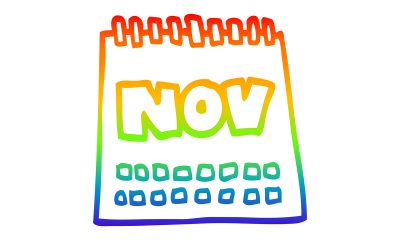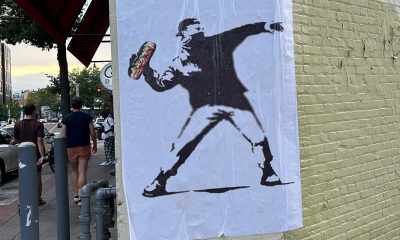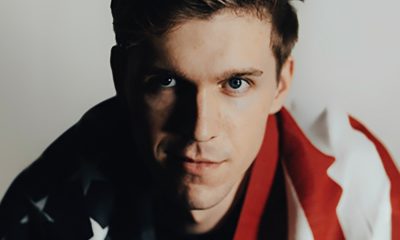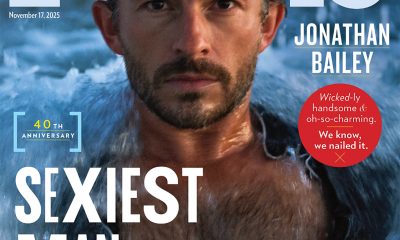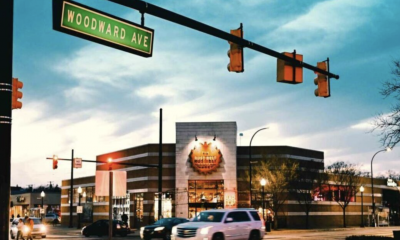District of Columbia
Shooting of gay man highlights concern over rising D.C. gun violence
‘A sense of growing lawlessness, increasing crime’
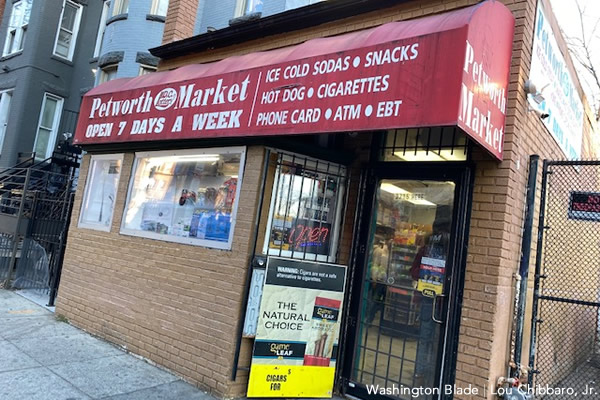
A gay man was shot twice in the hip and upper leg on Saturday morning, Dec. 11, while standing in front of a store next to the Georgia Avenue-Petworth Metro station in a development that his boyfriend says makes him yet another victim of an alarming rise in gun violence in the nation’s capital.
A D.C. police incident report says Larry Darnell Henderson, 36, was “hit twice in the lower extremities” by shots fired by an unidentified male suspect who fired nine shots into a crowd where Henderson was standing on Georgia Avenue, N.W., just before 10 a.m. on Dec. 11.
“Suspect 1 fled the scene northbound on the 3700 block of Georgia Ave. N.W., then turning eastbound into the 6700 block of Quincy St., N.W. where he was last seen,” the police report says.
Kevin McDonnell, who said he and Henderson are a couple, told the Blade that Henderson told him the male shooter initially pointed his gun at Henderson’s groin, prompting Henderson to turn his body around, which resulted in his being struck by bullets in the hip and leg.
According to McDonnell, Henderson told him the shooter did not say anything and did not attempt to rob him. But because the two men frequently patronize the stores and shops surrounding that Metro station and sometimes exhibit affection toward one another, McDonnell said he believes the shooter may have perceived Henderson to be a partner in a gay relationship and targeted him for a hate crime.
“It’s no accident that that guy pointed his gun at his genitalia,” McDonnell said. “And had LD not pivoted it would be a different story,” said McDonnell, who refers to Henderson by his nickname LD.
The police report specifically says the incident is not listed as a suspected hate crime. McDonnell disputes that designation.
When asked by the Blade if police investigators were looking for a possible video of the shooting incident from nearby surveillance cameras, a police spokesperson said if a photo of the suspect is obtained from a video camera and if police seek the public’s help in identifying and locating the suspect “we will release it.”
McDonnell said Henderson was taken by ambulance to MedStar Washington Hospital Center, where he underwent surgery. He remained at the hospital under treatment as of late Tuesday.
LGBTQ activists, meanwhile, have said they are not aware of any information to indicate that LGBTQ people are being singled out for gun violence or other types of crime to a degree greater than the general public.
A D.C. police spokesperson and the supervisor of the department’s LGBT Liaison Unit, Sgt. Nicole Brown, didn’t immediately respond to a message from the Blade asking whether officers assigned to the LGBT Liaison Unit have noticed an increase in crimes against LGBTQ people in the District during the past two years compared to previous years.
A police source familiar with the LGBT Liaison Unit, who spoke on condition of not being identified because the source was not authorized to speak to the media, said there was no “clear indication that LGBT people are being targeted any more than anyone else.”
D.C. police statistics for hate crimes posted on the police website show that for 2021, as of Sept. 30, there were a total of 29 reported hate crimes based on the victim’s sexual orientation and eight hate crimes reported based on the victim’s gender identity or expression.
Those figures compare to a total of 38 sexual orientation or anti-gay hate crimes reported in the full year of 2020 and 60 in 2019. The police data show that in 2020 there were 27 reported hate crimes based on the victim’s gender identity or status as a transgender person and the same number of 27 for that category reported in 2019.
Law enforcement observers have pointed out that the rise in violent crime in most of the nation’s large cities, including D.C., has occurred during the COVID pandemic and the COVID-related public health restrictions placed on many businesses and citizens across the country.
D.C. police data show that there was a 19 percent increase in homicides in the District in 2020 compared to 2019 – a jump from 166 to 198. As of Dec. 14, of this year, the D.C. police data show homicides rose so far in 2021 by 9 percent to a total of 212 cases as of Dec. 14.
This year’s homicide total of 212 as of Dec. 14 marked the first time the number of murders in the city has surpassed 200 since 2003, a development that has alarmed city officials and prompted D.C. Mayor Muriel Bowser last week to announce the city will expand its violence prevention and mitigation programs. Earlier this year, the mayor declared gun violence in the city a “public health crisis.”
As of that same Dec. 14, 2021, date, the D.C. police data show the crime of assault with a dangerous weapon rose by 3 percent over 2020 – from 1,581 to 1,605, robberies rose by 1 percent – 1,913 to 1,930, and the combined number of “violent crime” rose by 2 percent over 2020 from 3,855 to 3,919.
The 2021 data show that the number of burglaries declined by 4 percent so far in 2021 compared to 2020 from 1,136 to 1,094. The number of motor vehicle thefts rose by 9 percent from 3,068 in 2020 to 3,348 as of Dec. 14, 2021. The crime of “theft from auto” rose by 5 percent so far this year, from 7,897 to 8,307.
And the crime listed by D.C. police as “Theft/Other,” which is the second highest category of crime in the city, remained statistically the same but rose slightly from 10,409 in 2020 to 10,430 in 2021.
The police data show that the combined total of “property crime” in the city rose by 3 percent from 22,523 in 2020 to 23,182 as of Dec. 14, 2021.
The combined total of all instances of crime, the police data show, rose by 3 percent from 26,378 to 27,101 in 2021.
Although D.C.’s overall crime rate has not increased as much as it has in other cities, several high-profile incidents in parts of the city not accustomed to the shootings that residents of other parts of the city say they are accustomed to have alarmed businesses and nearby residents.
In July, two men were shot and wounded outside the popular strip of restaurants on 14th Street, N.W., where offices for Whitman-Walker Health are located and close to the Washington Blade’s former office. A short time later, a shooting outside Washington Nationals Stadium prompted fans inside the stadium to duck for cover and prompted demands for police and the city to do more to address gun violence.
The two high-profile shootings also drew attention to disagreements between Bowser and several members of the D.C. Council over whether or how much the fiscal year 2022 budget for the police department should be increased. Bowser and many community activists, including those in Wards 7 and 8, where the murder rate is highest, expressed concern that the number of police officers in the city is currently the lowest it has been in nearly 20 years due to retirements and attrition.
The Council in August voted to raise the police budget by $5 million, a little less than half of the $11 million that Bowser requested. The mayor has said the additional funds were needed to hire more officers to address the gun violence “crisis.”
Representatives of many of the city’s nightlife businesses, including restaurants and bars, have also expressed concern that legislation approved by the D.C. Council in recent years to place restrictions on how police make arrests of juveniles and people suffering from mental health problems have resulted in small businesses receiving less police protection against crimes targeting their customers and employees.
One law that some have objected to is the Neighborhood Engagement Achieves Results Amendment, or NEAR Act, of 2016. The law, among other things, requires that D.C. police coordinate with the city’s Department of Behavioral Health and Department of Human Services to arrange for civilian mental health clinicians and outreach specialists to join police officers in responding to crimes or disturbances caused by individuals identified as having mental illness, being homeless, or having substance abuse issues.
Although those raising concerns over the NEAR Act say they fully support providing mental health services for people who need those services, they say police in some cases have declined to respond to calls for “less serious” crimes such as “snatch-and-grab” purse and cell phone snatchings from people seated in outdoor dining areas at restaurants.
Some of the businesses have said police have expressed reluctance to respond if the suspected perpetrator has a mental health problem during evening hours when the civilian mental health experts from the Department of Behavioral Health or other city agencies are not working evening hours.
“A sense of growing lawlessness, increasing crime, and random violence is a much-discussed concern among local small business restaurant, bar, and retail store operators and workers throughout the city,” said Mark Lee, coordinator of the D.C. Nightlife Council, a local trade association representing nightlife, hospitality, and entertainment businesses in D.C.
Lee said representatives of these businesses have met recently with D.C. Council members and D.C. Police Chief Robert Contee to inform them that safety concerns by employees have begun to harm businesses and negatively impact commercial sections of the city.
“MPD leadership and rank-and-file officers, I think it’s fair to say, are as frustrated as many city residents and local enterprises have become about a D.C. Council majority that pretends it is reassigning parts of public safety and law enforcement to other government entities that are understaffed, undertrained, and largely unavailable to respond to incidents and problems,” Lee said.
He noted that because the D.C. police force is the smallest it has been in 20 years, despite population increases, “officers are stretched thin working overtime shifts.”
D.C. Council member Robert White (D-At-Large), who is running for mayor in the 2022 Democratic primary, is among the Council members who have said addressing the underlying causes of crime in the city is the only way the city can succeed in ending gun violence and other serious crimes.
“The reality is unless we start to solve these underlying issues more, crime is going to go up,” White told the Blade at a holiday event sponsored by the LGBTQ group Capital Stonewall Democrats on Monday night. “But also, once people are incarcerated, if we rehabilitate them better, crime is going to go down,” White said.
“So, being a police officer is an incredibly difficult job,” he said. “And I guess they believe – some believe – that if we lock up more people for longer periods of time, that’s going to make us safe,” White said. “And I think that fundamentally isn’t true. There has to be consequences when people commit crimes. But we can do a better job rehabilitating people,” he said.
“We can do a better job of getting to the people before they get engaged in crime. And we can do a better job of restoring the relationship between communities and the police,” White said.
Bowser and city officials working in her administration have said both approaches are needed to address the gun violence problem, including at this time the hiring of more police officers. On Dec. 9, the mayor announced plans to significantly increase the city’s ongoing violence prevention and interruption programs. Among other things, Bowser said the city will award $1.1 million in grants to community-based organizations working on violence interruption programs, especially those targeting young people.
Del McFadden, director of the D.C.Office of Neighborhood Safety and Engagement, which coordinates violence prevention efforts, said the number of “interrupters” will increase from 30 to 80. He said their work would expand to more neighborhoods, including Shaw in Ward 2, Congress Park in Ward 8, and Edgewood in Ward 5 for a total of 25 “priority” neighborhoods where gun violence has occurred.
District of Columbia
‘Sandwich guy’ not guilty in assault case
Sean Charles Dunn faced misdemeanor charge
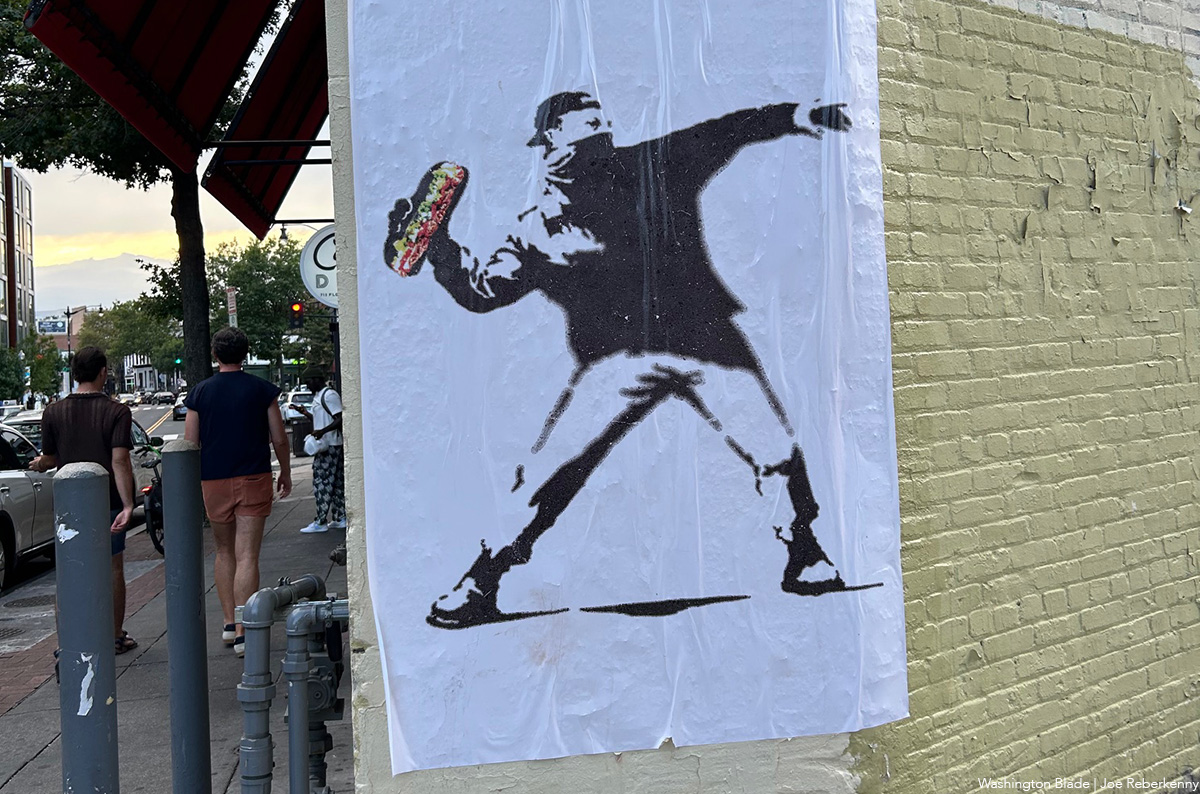
A jury with the U.S. District Court for the District of Columbia on Thursday, Nov. 6, found D.C. resident Sean Charles Dunn not guilty of assault for tossing a hero sandwich into the chest of a U.S. Customs and Border Protection agent at the intersection of 14th and U streets, N.W. at around 11 p.m. on Aug. 10.
Dunn’s attorneys hailed the verdict as a gesture of support for Dunn’s contention that his action, which was captured on video that went viral on social media, was an exercise of his First Amendment right to protest the federal border agent’s participating in President Donald Trump’s deployment of federal troops on D.C. streets.
Friends of Dunn have said that shortly before the sandwich tossing incident took place Dunn had been at the nearby gay nightclub Bunker, which was hosting a Latin dance party called Tropicoqueta. Sabrina Shroff, one of three attorneys representing Dunn at the trial, said during the trial after Dunn left the nightclub he went to the submarine sandwich shop on 14th Street at the corner of U Street, where he saw the border patrol agent and other law enforcement officers standing in front of the shop.
Shroff and others who know Dunn have said he was fearful that the border agent outside the sub shop and immigrant agents might raid the Bunker Latin night event. Bunker’s entrance is on U Street just around the corner from the sub shop where the federal agents were standing.
“I am so happy that justice prevails in spite of everything happening,“ Dunn told reporters outside the courthouse after the verdict while joined by his attorneys. “And that night I believed that I was protecting the rights of immigrants,” he said.
“And let us not forget that the great seal of the United States says, E Pluribus Unum,” he continued. “That means from many, one. Every life matters no matter where you came from, no matter how you got here, no matter how you identify, you have the right to live a life that is free.”
The verdict followed a two-day trial with testimony by just two witnesses, U.S. Customs and Border Protection agent Gregory Lairmore, who identified Dunn as the person who threw the sandwich at his chest, and Metro Transit Police Detective Daina Henry, who told the jury she witnessed Dunn toss the sandwich at Lairmore while shouting obscenities.
Shroff told the jury Dunn was exercising his First Amendment right to protest and that the tossing of the sandwich at Lairmore, who was wearing a bulletproof vest, did not constitute an assault under the federal assault law to which Dunn was charged, among other things, because the federal agent was not injured.
Prosecutors with the Office of the U.S. Attorney for D.C. initially attempted to obtain a grand jury indictment of Dunn on a felony assault charge. But the grand jury refused to hand down an indictment on that charge, court records show. Prosecutors then filed a criminal complaint against Dunn on the misdemeanor charge of assaulting, resisting, or impeding certain officers of the United States.
“Dunn stood within inches of Victim 1,” the criminal complaint states, “pointing his finger in Victim 1’s face, and yelled, Fuck you! You fucking fascists! Why are you here? I don’t want you in my city!”
The complaint continues by stating, “An Instagram video recorded by an observer captured the incident. The video depicts Dunn screaming at V-1 within inches of his face for several seconds before winding his arm back and forcefully throwing a sub-style sandwich at V-1.
Prosecutors repeatedly played the video of the incident for the jurors on video screens in the courtroom.
Dunn, who chose not to testify at his trial, and his attorneys have not disputed the obvious evidence that Dunn threw the sandwich that hit Lairmore in the chest. Lead defense attorney Shroff and co-defense attorneys Julia Gatto and Nicholas Silverman argued that Dunn’s action did not constitute an assault under the legal definition of common law assault in the federal assault statute.
Assistant U.S. Attorney Michael DiLorenzo, the lead prosecutor in the case, strongly disputed that claim, citing various provisions in the law and appeals court rulings that he claimed upheld his and the government’s contention that an “assault” can take place even if a victim is not injured as well as if there was no physical contact between the victim and an alleged assailant, only a threat of physical contact and injury.
The dispute over the intricacies of the assault law and whether Dunn’s action reached the level of an assault under the law dominated the two-day trial, with U.S. District Court Judge Carl J. Nichols, who presided over the trial, weighing in with his own interpretation of the assault statute. Among other things, he said it would be up to the jury to decide whether or not Dunn committed an assault.
Court observers have said in cases like this, a jury could have issued a so-called “nullification” verdict in which they acquit a defendant even though they believe he or she committed the offense in question because they believe the charge is unjust. The other possibility, observers say, is the jury believed the defense was right in claiming a law was not violated.
DiLorenzo and his two co-prosecutors in the case declined to comment in response to requests by reporters following the verdict.
“We really want to thank the jury for having sent back an affirmation that his sentiment is not just tolerated but it is legal, it is welcome,” defense attorney Shroff said in referring to Dunn’s actions. “And we thank them very much for that verdict,” she said.
Dunn thanked his attorneys for providing what he called excellent representation “and for offering all of their services pro bono,” meaning free of charge.
Dunn, an Air Force veteran who later worked as an international affairs specialist at the U.S. Department of Justice, was fired from that job by DOJ officials after his arrest for the sandwich tossing incident.
“I would like to thank family and friends and strangers for all of their support, whether it was emotional, or spiritual, or artistic, or financial,” he told the gathering outside the courthouse. “To the people that opened their hearts and homes to me, I am eternally grateful.”
“As always, we accept a jury’s verdict; that is the system within which we function,” CNN quoted U.S. Attorney for D.C. Jeanine Pirro as saying after the verdict in the Dunn case. “However, law enforcement should never be subjected to assault, no matter how ‘minor,’” Pirro told CNN in a statement.
“Even children know when they are angry, they are not allowed to throw objects at one another,” CNN quoted her as saying.
District of Columbia
Trial begins for man charged with throwing sandwich at federal agent
Jury views video of incident that went viral on social media

Prosecutors showed jurors a video of Sean Charles Dunn throwing a sub sandwich into the chest of a U.S. Customs and Border Protection agent at the bustling intersection of 14th and U streets, N.W. at around 11 p.m. on Aug. 10 of this year on the opening day of Dunn’s trial that has drawn national attention.
According to a knowledgeable source, Dunn threw the sandwich at the agent after shouting obscenities at him and other federal law enforcement officers who were stationed at that location after he was refused admission to the nearby gay bar Bunker for being too intoxicated.
Charging documents and reports by witnesses show that Dunn expressed outrage that the federal officers were stationed there and at other locations in D.C. under orders from President Donald Trump to help curtail crime in the city.
Prosecutors with the Office of the U.S. Attorney for D.C. initially attempted to obtain a grand jury indictment of Dunn on a felony assault charge, but the grand jury refused to hand down an indictment on that charge, court records show. Prosecutors then filed a criminal complaint against Dunn on the misdemeanor charge of assaulting, resisting, or impeding certain officers of the United States.
“Dunn stood within inches of Victim 1,” a criminal complaint states, “pointed his finger in Victim 1’s face, and yelled, Fuck you! You fucking fascists! Why are you here? I don’t want you in my city!”
The complaint adds, “Dunn continued his conduct for several minutes before crossing the street and continuing to yell obscenities at V-1. At approximately 11:06 p.m. Dunn approached V-1 and threw a sandwich at him, striking V-1 in the chest.”
The complaint continues by stating, “An Instagram video recorded by an observer captured the incident. The video depicts Dunn screaming at V-1 within inches of his face for several seconds before winding his arm back and forcefully throwing a sub-style sandwich at V-1.”
At the opening day of testimony at the trial on Tuesday, Nov. 4, V-1, who was identified as Customs and Border Patrol Agent Gregory Lairmore, testified as the first government witness. Also testifying was Metro Transit Police Detective Daina Henry, who said she was present at the scene and saw Dunn throw the sandwich at Lairmore.
The position taken by Dunn’s defense attorneys is outlined in a 24-page memorandum in support of a motion filed on Oct. 15 calling for the dismissal of the case, which was denied by U.S. District Court Judge Carl J. Nichols.
“This prosecution is a blatant abuse of power,” the defense memo states. “The federal government has chosen to bring a criminal case over conduct so minor it would be comical – were it not for the unmistakable retaliatory motive behind it and the resulting risk to Mr. Dunn.”
It adds, “Mr. Dunn tossed a sandwich at a fully armed, heavily protected Customs and Border Protection {CBP} officer. That act alone would never have drawn a federal charge. What did was the political speech that accompanied it.”
The trial was scheduled to resume at 9 a.m. on Wednesday, Nov. 5.
District of Columbia
D.C. mayor announces use of local funds for SNAP food aid
Md., Va. arrange for similar local replacement of federal money
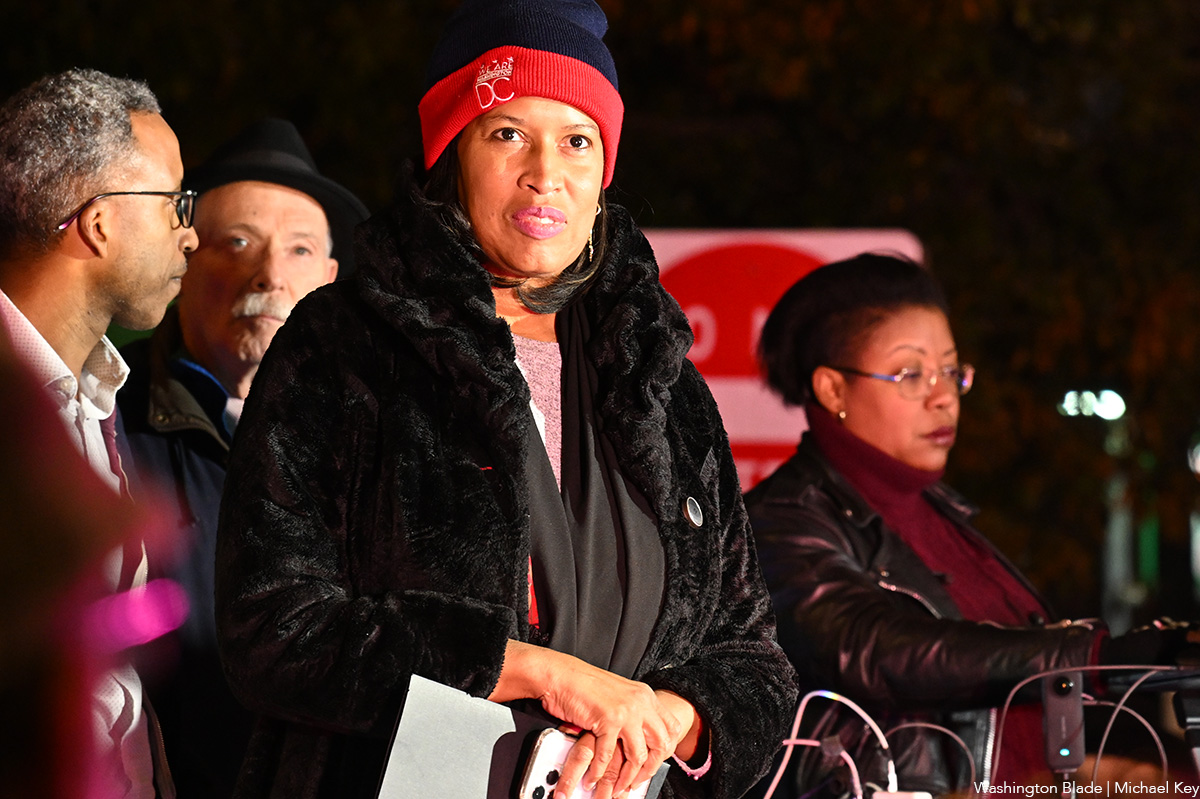
D.C. Mayor Muriel Bowser announced on Oct. 30 that she has arranged for at least $129 million in local D.C funds to be used to support as many as 141,000 D.C. residents in need who depend on the federal food assistance programs known as SNAP and WIC whose funding will be cut off beginning Nov. 1 due to the federal shutdown.
SNAP, which stands for the Supplemental Nutrition Assistance Program, and WIC, the Women, Infants, and Children Program, provide food related services for 10 million or more people in need nationwide.
Maryland Gov. Wes Moore, Virginia Gov. Glenn Youngkin, and Delaware Gov. Matt Meyer also announced similar plans to provide emergency state funds to replace the federal funds cut off beginning Nov. 1 for the two food programs.
Similar to Bowser, Moore and Youngkin said their replacement funds at this time would only last for the month of November. Each said they were hopeful that Congress would end the shutdown before the end of November.
“We know that SNAP and WIC play a critical role in keeping thousands of Washingtonians and millions of Americans put food on the table each month,” Bowser said in a statement. “We were hopeful it wouldn’t come to this – and we will need the federal government to reopen as soon as possible – but for right now, we’re moving forward to ensure we take care of D.C. residents in November,” she said.
The mayor’s statement says about 85,000 D.C. households, consisting of 141,000 individuals, receive SNAP support each month, with an average monthly allocation of $314. It says more than 12,500 city residents in 8,300 households benefit from the WIC program.
A spokesperson for the D.C. Mayor’s Office of LGBTQ Affairs couldn’t immediately be reached to determine whether the city has an estimated count of how many LGBTQ residents receive support from the SNAP and SIC programs.
-

 District of Columbia2 days ago
District of Columbia2 days ago‘Sandwich guy’ not guilty in assault case
-

 Sports2 days ago
Sports2 days agoGay speedskater racing toward a more inclusive future in sports
-

 Celebrity News4 days ago
Celebrity News4 days agoJonathan Bailey is People’s first openly gay ‘Sexiest Man Alive’
-

 Michigan4 days ago
Michigan4 days agoFBI thwarts Halloween terror plot targeting Mich. LGBTQ bars

